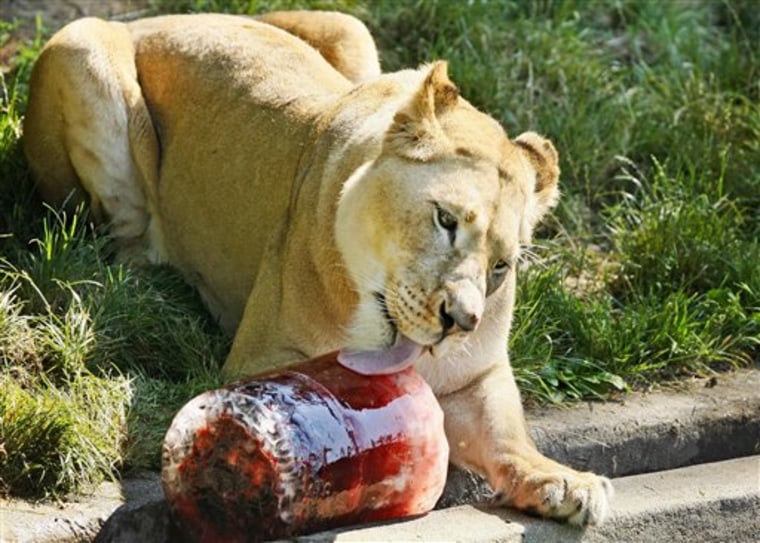Otters sweltering in the summer sun suck on "fishsicles." For carnivores like the Amur leopard, it's "bloodsicles."
Zoos across the country are using icy treats, shade, water and every conceivable form of cooling machine to help hundreds of thousands of animals, visitors and workers beat the heat this summer.
Even animals from Africa can have problems with extreme heat, says Lion Country Safari wildlife director Terry Wolf.
"It can be pretty stressful to some of them," he said. So at the Loxahatchee park in southern Florida, rhinos, tortoises and birds have slushy wet mud holes and the water buffalo have canals and lakes pumped full of water. Diets have changed from winter protein to summer fiber.
Earlier this month, temperatures soared past 100 in New York City, Philadelphia, Boston, Washington, D.C., and Newark, N.J., and broke records in Providence, R.I., and Hartford, Conn. In the West, Southern California, Arizona and New Mexico were in triple digits. Death Valley in eastern California reached 125 degrees.
The lions have wet moats, primates and outdoor birds get shade and mist, jaguars and Andean bears have swimming pools, and the orangutans hang out near air conditioning vents at the Houston Zoo, said Brian Hill, director of public affairs.
Ice, frozen in everything from snowcone cups to 25-gallon buckets, is a heat treat. the Essex County Turtle Back Zoo in West Orange, N.J., uses fishsicles and bloodsicles, along with "fruitsicles" for bears and ice cream and Italian ices for the humans, explained zoo director Jeremy Goodman.
Some animals sweat and some are just as susceptible as humans to heat stroke and heat exhaustion. Some even get sunburned.
"We apply sunscreen to our pig," Goodman said.
The Phoeniz (Ariz.) Zoo is probably the nation's hottest, said Dan Subaitis, director of animal management there for the past five years. For three months every summer, it is 110 to 115 degrees during the day, the humidity reaches 60 percent and the nights might "cool off" to 90 or 100 degrees, he said. Staff constantly watches the animals, guests and each other for signs of heat distress.
"Our reptile collection likes heat, but our heat is even too hot for most of them, so they will head for their pools," Subaitis said.
You won't find any moose or polar bears at the zoo because it would cost too much to keep them cool.
The orangutans have learned to help by making their own hats, Subaitis said. "We give them old shirts or burlap sacks and they will get them wet and drape them over their heads."
Throughout the zoo, there are fans, misters, evaporative coolers, trees, grass, artificial shade, ponds, sprinklers, spouts, hoses, drinking fountains and rest areas. Guests can bring fully stocked coolers and ice chests and visit starting at 7 a.m.
Besides keeping them cool, workers try to keep the animals calm, reducing as much stress as possible. They put off as many summer veterinary procedures as they can.
"We do not want an animal to get agitated or nervous. That will increase body temperature and if you add that to an environmental temperature of 110, they can get overheated real quick," Subaitis said.

Wolf echoed the stress concerns. "If we have to put our hands on an animal because they have some kind of medical issue, we have to juggle whether or not the issue is more critical than what might happen if they overheat in the capture process," he said.
A new, $20 million, 17-acre Polar Frontier at the Columbus (Ohio) Zoo and Aquarium has an acre-plus home for 3-year-old polar bear sisters Anana and Aurora.
The 600-pound bears have a chilled pool (stocked with 500 or 600 trout), trees, a grassy area, and 24-hour access to air conditioned dens, said Doug Warmolts, director of animal care.
They get piles of ice to roll in and heavy duty balls or 55-gallon plastic drums to roll around, he said.
"There are big rocks next to the side of the pool and they leap off and do these great belly smackers," Warmolts said.
Anyone worried about nature taking its course can be assured that the heat does little to stop the birds and the bees.
The Cincinnati (Ohio) Zoo & Botanical Garden is nicknamed the "sexiest zoo in America" because of all the births there through the years. The title is probably safe because heat doesn't alter the sex lives of animals as much as instinct and light does, explained curator of mammals Mike Dulaney.